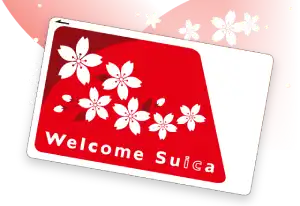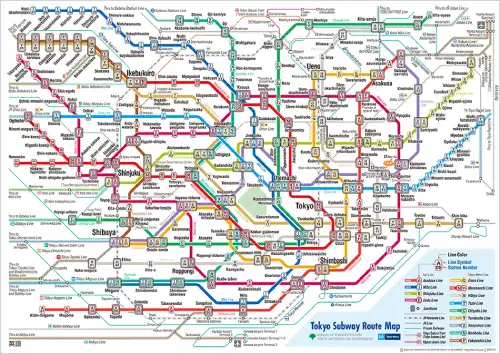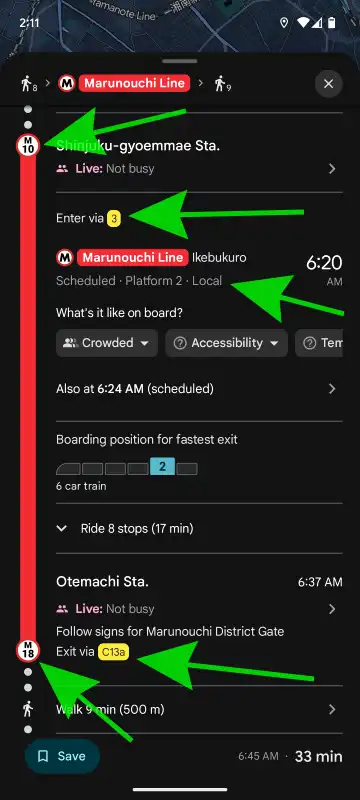Surviving Tokyo: Quick Travel Tips
Tokyo might seem overwhelming, but it's easier than you think
Published: March 23, 2025
Updated: June 15, 2025

Tokyo can feel overwhelming at first, but trust me, it's easier than you think! Coming from the USA, I found it surprisingly convenient and efficient, full of incredible experiences. These tips are based on my own adventures in Tokyo, and while everyone's journey is different, I hope they give you the confidence to explore with ease and make the most of your trip.
A Little Etiquette Goes a Long Way

Japanese etiquette can seem intimidating, but don't stress too much! You'll find tons of articles about Japanese etiquette, and a lot of it's good advice. But here are the key things to keep in mind for a smooth experience:
- Keep the noise down - Japan is a pretty quiet country. Try to match the sound level around you. This is really the biggest thing.
- Follow the rules - They're there for a reason! Even if something seems odd, go with the flow. No eating on trains, and be sure to stand behind the yellow line at train stations.
- Blend in (a little) - Just observing what others do can make a big difference. Walk on the left side of sidewalks (except in Osaka!) and face forward on trains.
Japanese to Know

If you don't have time to properly learn Japanese, just focus on these key phrases. They'll take you far.
- Sumimasen - Seriously, learn "Sumimasen". You'll use it constantly. This is your Swiss Army Knife! It means "excuse me" or "sorry". Use it to get someone's attention, apologize lightly, or navigate a crowded space.
- Arigato Gozaimasu - A polite "thank you". Perfect for interacting with shop staff or restaurant servers.
- Onegaishimasu - A more formal "please". Especially useful when ordering food. Just point to an item on the menu and say, "onegaishimasu".
Your Phone: Your Best Friend in Tokyo

Having a smart phone with data makes planning and getting around Tokyo so much easier. With the right apps, you can make the most of your trip, stay in touch with the people who matter most, and even find great food recommendations.
Essential Apps
Besides Google Maps and Google Translate (download offline maps and Japanese language!), these apps can really simplify things:
- NERV - A disaster prevention app that provides real-time alerts for earthquakes, tsunamis, and other emergencies. Set it up and turn on notifications.
- GO Taxi - Like Uber or Lyft, this app makes hailing a taxi super easy. Enter your destination, set your pickup, and a taxi will come to you. Credit cards are accepted.
- Suikakeibo - This is only if you're using a physical Suica card. If you have a mobile Suica (through your iPhone), you're covered and can check your balance in your phone's wallet.
Getting Data
If your phone is unlocked and supports eSIM, I highly recommend using one of these providers:
Think of an eSIM like adding a virtual SIM card to your phone.
If you have a dual-SIM phone, you can use your regular SIM for calls and texts while using your eSIM for data. It's a great combo! I'm doing this on my Pixel 7 with WiFi calling enabled, and it works great. It should work on iOS too.
If your phone doesn't support eSIM, you have two main options:
- Check with your carrier for international roaming plans.
- Rent a pocket WiFi device, such as one from Japan Wireless. Keep in mind you'll need to keep track of it, charge it, and it limits your group's ability to split up.
I've always used an eSIM in Japan (which works great!), so I don't have firsthand experience with the other options, but they are commonly used by travelers.
Getting Around
Tokyo is easy to get around with all of the public transportation options available. I tend to stick with Google Maps for most of my getting around, as it provides accurate subway times and helps me find the fastest route to a destination.
Paying for Transport

To pay for trains and buses, you have a few options:
- Paper Tickets - Available at ticket machines, but not recommended due to the hassle.
- IC Cards (Suica, Pasmo, etc.) - Convenient rechargeable transit cards.
- Mobile Suica (iPhone only for travelers) - The Suica app works on iPhones and Android phones purchased in Japan.
I always use the Welcome Suica physical card. It's like a regular Suica but with these key differences:
| Feature | Regular Suica | Welcome Suica |
|---|---|---|
| Target Audience | General public | Tourists |
| Expires | ✔️ 10 years after last use | ❌ 28 days (regardless of use) |
| Deposit | ❌ Required | ✔️ Not required |
| Refunds | ✔️ Allowed | ❌ Not allowed |
You buy a Welcome Suica with a credit card and add money to it. Just remember it expires after 28 days! You can't get a refund on any money left on it, so spend it at convenience stores before you leave. PiQtour has a great article and video on Suica and IC cards.
How to Navigate the Metro

The easiest way to get around is to use Google Maps. Enter your destination and select the public transport option.
I like to adjust a few settings for better results:
- Set preferred mode to train and rail.
- Change filter by to Less walking to prioritize routes with minimal walking.
- Set connecting modes to ride services (turn off drive and bicycle).
For example, let's say you're going from Shinjuku Gyoen National Garden to the Imperial Palace East Garden:

I've marked key details for navigating the metro:
- Your starting station is Shinjuku-gyoemmae Sta. (M10).
- Find the Marunouchi Line (look for the red "M" symbol), head to Platform 2, and board a local train (express and limited express trains skip certain stops, while local trains go to every stop on their line).
- Google Maps often suggests the best train car for a quick exit.
- Get off at Otemachi Sta. (M18).
- Exit via C13a. If you don't see it, follow signs for Marunouchi District Gate.
Quick Tips for a Smooth Trip
Here are some final quick tips:
- Pack light if you can.
- Bring some Japanese Yen in cash. Credit cards are accepted in many places, but you'll likely need physical cash at some point. I tend to spend around ¥10,000 per person per week in cash, unless I go on a serious gotcha machine spree.
- Always carry your passport. It's your official ID in Japan, and authorities can request to see it.
- Be prepared for lots of walking and stairs (wear comfortable shoes or whatever works for you).
- Bathrooms in Japan are great, but the ones in shopping centers, restaurants, and hotels tend to be the best.
- Bring hand sanitizer in case a public bathroom doesn't have soap.
- Pack your suitcase inside another suitcase so you can bring back two if you shop a lot.
- Aim to stay within a 5-10 minute walk of a Tokyo Metro or JR line. Easy access to transit is your friend!
- When given the option to pay in Japanese Yen or US Dollars, choose Yen. With 1 USD ≈ 150 JPY as of this writing, you'll usually get a better deal.
- Deodorant can be harder to find in Japan, so it's a good idea to bring some with you. Seriously, you'll thank me later!
- Fill out your customs form in advance through Japan Web and use the QR code at customs instead of handwriting a form. It's a massive time-saver at the airport!
More Resources
I'm always discovering new resources. These are just a few of my favorites right now.
- Websites:
- Tokyo Cheapo - A go-to resource for budget-friendly travel tips, including accommodations, dining, and activities.
- Japan Guide - A comprehensive travel site covering destinations, attractions, and cultural insights across Japan.
- Videos:
- PiQtour YouTube - Abby covers useful guides on topics like buying Shinkansen tickets, finding Character Street in Tokyo Station, and choosing the right IC card.
- Abroad in Japan - Entertaining and informative videos from Chris Broad, covering life in Japan, travel adventures, and cultural insights.
- Seerasan - Tokyo travel guides and casual vlogs featuring local spots, cafes, and hidden gems.
- Allison in Tokyo - A mix of daily life, food, and travel content from an expat perspective.
- Live streamers:
- PremierTwo - IRL streams capturing life in Japan, from city walks to train rides and events.
- CDawgVA - Fun, chaotic adventures in Japan, from biking cross-country to exploring niche subcultures.
- robcdee - IRL streams featuring humor, spontaneous interactions, and deep dives into Tokyo's hidden gems.
- Forums:
- r/JapanTravelTips - A helpful subreddit where travelers share tips, itineraries, and experiences. There's tons of great info on there, but you're bound to find different folks have different opinions. Just something to keep in mind.
- r/JapanTravel - One of the biggest Japan travel subreddits, great for general questions, itinerary help, and travel updates.